最新2015中考英语语法总复习讲义
- 格式:doc
- 大小:435.50 KB
- 文档页数:27
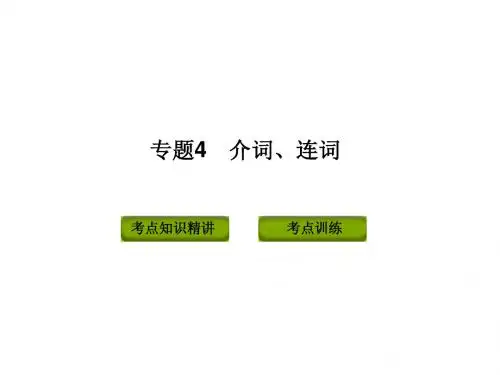
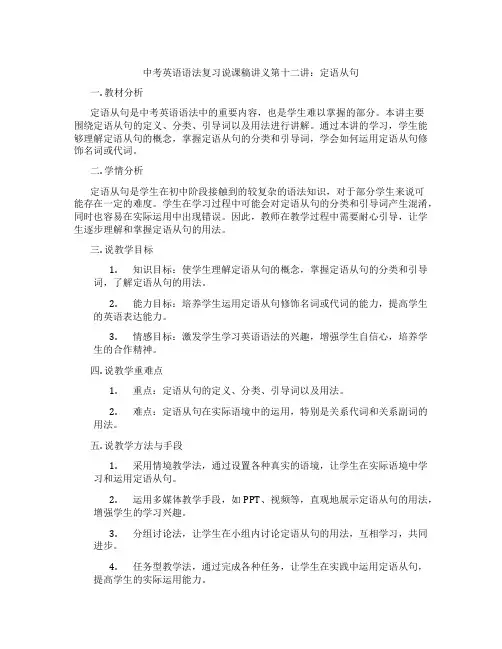
中考英语语法复习说课稿讲义第十二讲:定语从句一. 教材分析定语从句是中考英语语法中的重要内容,也是学生难以掌握的部分。
本讲主要围绕定语从句的定义、分类、引导词以及用法进行讲解。
通过本讲的学习,学生能够理解定语从句的概念,掌握定语从句的分类和引导词,学会如何运用定语从句修饰名词或代词。
二. 学情分析定语从句是学生在初中阶段接触到的较复杂的语法知识,对于部分学生来说可能存在一定的难度。
学生在学习过程中可能会对定语从句的分类和引导词产生混淆,同时也容易在实际运用中出现错误。
因此,教师在教学过程中需要耐心引导,让学生逐步理解和掌握定语从句的用法。
三. 说教学目标1.知识目标:使学生理解定语从句的概念,掌握定语从句的分类和引导词,了解定语从句的用法。
2.能力目标:培养学生运用定语从句修饰名词或代词的能力,提高学生的英语表达能力。
3.情感目标:激发学生学习英语语法的兴趣,增强学生自信心,培养学生的合作精神。
四. 说教学重难点1.重点:定语从句的定义、分类、引导词以及用法。
2.难点:定语从句在实际语境中的运用,特别是关系代词和关系副词的用法。
五. 说教学方法与手段1.采用情境教学法,通过设置各种真实的语境,让学生在实际语境中学习和运用定语从句。
2.运用多媒体教学手段,如PPT、视频等,直观地展示定语从句的用法,增强学生的学习兴趣。
3.分组讨论法,让学生在小组内讨论定语从句的用法,互相学习,共同进步。
4.任务型教学法,通过完成各种任务,让学生在实践中运用定语从句,提高学生的实际运用能力。
六. 说教学过程1.导入:通过一个谜语引发学生对定语从句的好奇心,激发学生的学习兴趣。
2.讲解:讲解定语从句的定义、分类、引导词以及用法,结合实例进行分析。
3.练习:让学生进行定语从句的练习,及时纠正学生在练习中出现的错误。
4.情境创设:设置各种真实的语境,让学生在语境中运用定语从句。
5.分组讨论:让学生在小组内讨论定语从句的用法,互相学习,共同进步。
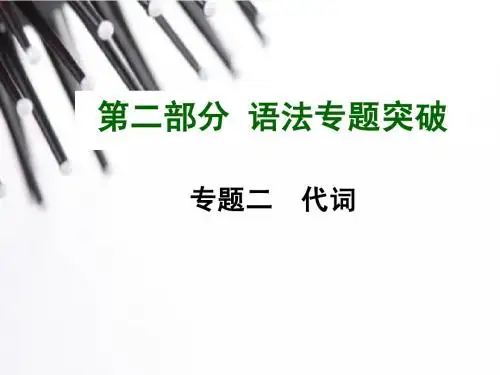
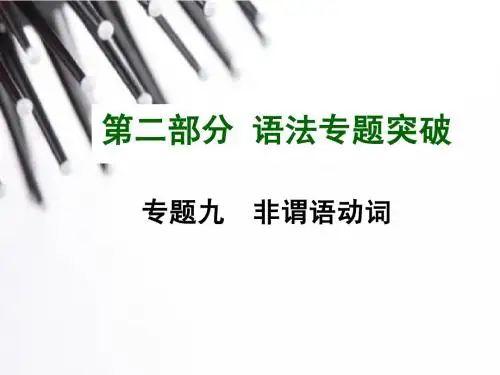
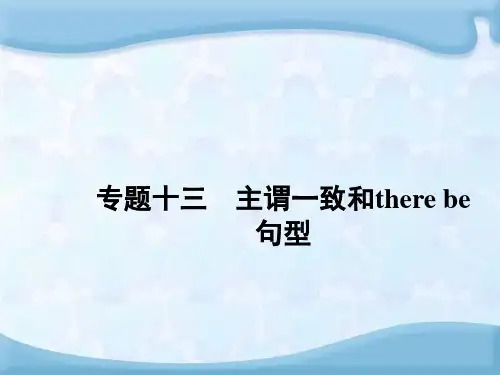
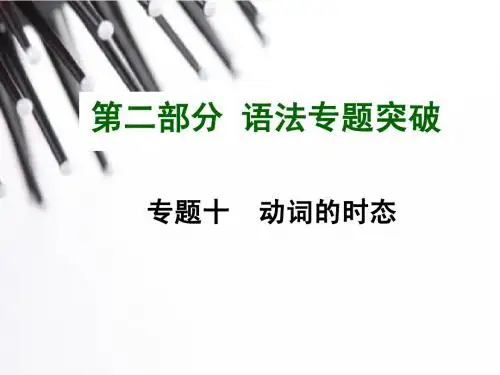
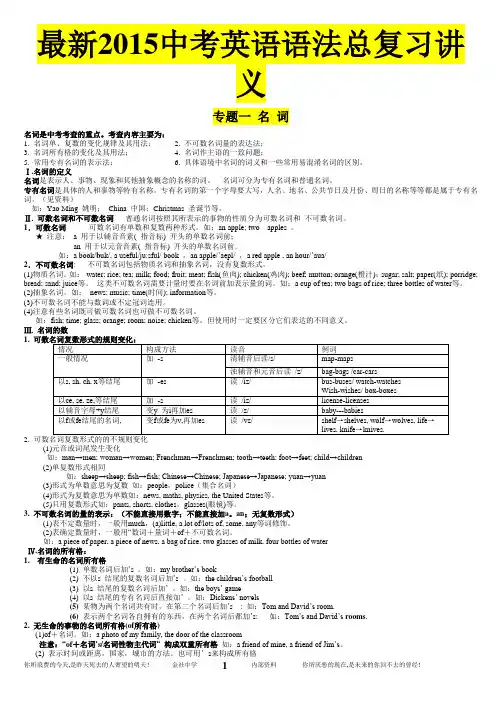
最新2015中考英语语法总复习讲义专题一名词名词是中考考查的重点。
考查内容主要为:1. 名词单、复数的变化规律及其用法;2. 不可数名词量的表达法;3. 名词所有格的变化及其用法;4. 名词作主语的一致问题;5. 常用专有名词的表示法;6. 具体语境中名词的词义和一些常用易混淆名词的区别。
Ⅰ.名词的定义名词是表示人、事物、现象和其他抽象概念的名称的词。
名词可分为专有名词和普通名词。
专有名词是具体的人和事物等特有名称。
专有名词的第一个字母要大写,人名、地名、公共节日及月份、周日的名称等等都是属于专有名词。
(见资料)如:Yao Ming 姚明;China 中国;Christmas 圣诞节等。
Ⅱ. 可数名词和不可数名词普通名词按照其所表示的事物的性质分为可数名词和不可数名词。
1.可数名词可数名词有单数和复数两种形式。
如:an apple; two apples 。
★注意:a 用于以辅音音素( 指音标) 开头的单数名词前;an 用于以元音音素( 指音标) 开头的单数名词前。
如:a book/b uk/, a useful/ju:sful/ book ,an apple/’aepl/ ,a red apple , an hour/’aua/2.不可数名词: 不可数名词包括物质名词和抽象名词,没有复数形式。
(1)物质名词。
如:water; rice; tea; milk; food; fruit; meat; fish(鱼肉); chicken(鸡肉); beef; mutton; orange(橙汁);sugar; salt; paper(纸); porridge; bread; sand; juice等。
这类不可数名词需要计量时要在名词前加表示量的词。
如:a cup of tea; two bags of rice; three bottles of water等。
(2)抽象名词。
如:news; music; time(时间); information等。
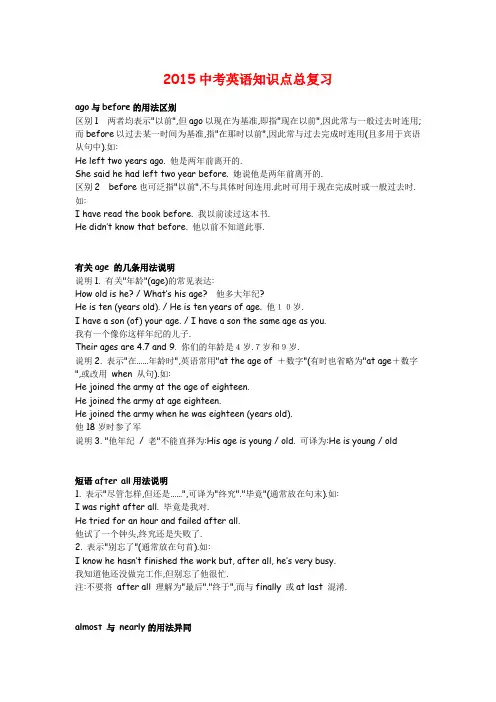
2015中考英语知识点总复习ago与before的用法区别区别1 两者均表示"以前",但ago以现在为基准,即指"现在以前",因此常与一般过去时连用;而before以过去某一时间为基准,指"在那时以前",因此常与过去完成时连用(且多用于宾语从句中).如:He left two years ago. 他是两年前离开的.She said he had left two year before. 她说他是两年前离开的.区别2 before也可泛指"以前",不与具体时间连用.此时可用于现在完成时或一般过去时.如:I have read the book before. 我以前读过这本书.He didn’t know that before. 他以前不知道此事.有关age 的几条用法说明说明1. 有关"年龄"(age)的常见表达:How old is he? / What’s his age?他多大年纪?He is ten (years old). / He is ten years of age. 他10岁.I have a son (of) your age. / I have a son the same age as you.我有一个像你这样年纪的儿子.Their ages are 4.7 and 9. 你们的年龄是4岁.7岁和9岁.说明2. 表示"在……年龄时",英语常用"at the age of +数字"(有时也省略为"at age+数字",或改用when 从句).如:He joined the army at the age of eighteen.He joined the army at age eighteen.He joined the army when he was eighteen (years old).他18岁时参了军说明3. "他年纪/ 老"不能直择为:His age is young / old. 可译为:He is young / old短语after all用法说明1. 表示"尽管怎样,但还是……",可译为"终究"."毕竟"(通常放在句末).如:I was right after all. 毕竟是我对.He tried for an hour and failed after all.他试了一个钟头,终究还是失败了.2. 表示"别忘了"(通常放在句首).如:I know he hasn’t finished the work but, after all, he’s very busy.我知道他还没做完工作,但别忘了他很忙.注:不要将after all 理解为"最后"."终于",而与finally 或at last 混淆.almost 与 nearly的用法异同一.相同之处两者均可表示"几乎""差不多",均可修饰不定代词.形容词.副词.动词.介词短语等,此时两者常可换用.如:I t’s almost [nearly] impossible. 那几乎是不可能的.(修饰形容词)He almost [nearly] always arrives late. 他差不多总是迟到.(修饰副词)He fell and almost [nearly] broke his leg. 他摔了一跤,险些摔断了腿.(修饰动词) Almost [Nearly] all the students passed the exam. 差不多所有的学生都通过了考试.(修饰不定代词)注意:修饰动词时,通常应放在行为动词之前,特殊动词之后(见上例);修饰形容词.副词.名词等时,通常应将其放在被修饰词语之前,否则会造成错误.如:◎他工作了几乎一整天.正:He worked almost all day.误:He almost worked all day.◎我们当中几乎每一个人都读过这本书.正:Almost every one of us read the book.误:Every one of us almost read the book.二.不同之处1. almost 可用于any 以及no, none, nobody, nothing, never 等否定词之前,但nearly 一般不这样用.如:Almost any man can do it. 几乎任何人都会做.Almost no one came to the party. 几乎没有人来参加晚会.I almost never see her. 我几乎从未见过她.但是,两者都可用在否定动词之前.如:( )He almost [nearly] didn’t catch the bus. 他差点没赶上公共汽车.2. nearly 前可用very, pretty, not 等词修饰,但almost 之前不能用这些词.如:It’s not nearly so difficult as you think. 这远不像你想象的那么难.The car is pretty nearly new. 这汽车几乎是全新的.注:not nearly 意为"远非",very [pretty] nearly 意为"几乎",都是习语.3. 有时almost 可表示十分相似(但又不完全相同),此时不用nearly.如:I almost wish I’d stayed at home. 我真有点后悔没在家里呆着.Our cat understands everything —he’s almost human. 我们这只猫什么都懂——快通人性了.含有add的四个有用短语1. add in 包括.如:Don’t forget to add me in. 别忘了把我也算上.Would you add in these items, please? 请你把这些条款包括进去好吗?2. add to 增加.如:This adds to our difficulties. 这增加了我们的困难.It adds to my pleasure to see you here today. 今天在这里见到你我格外高兴.3. add up(1) 加起来.如:You haven’t added the figures up right. 这些数字你没有加对.(2) 有意义,有道理(主要用于口语中,且主要用于否定句).如:His excuse just doesn’t add up. 他的借口完全站不住脚.What he said doesn’t add up. 他说的话自相矛盾.4. add up to(1) 加起来等于,总计.如:The figures add up to 500. 这些数字加起来等于500.The costs added up to 1000 dollars. 费用总计为1000美元.(2) 总起来看说明了.如:( )Your long answer just adds up to a refusal. 你的冗长回答简直等于拒绝.The evidence all adds up to a case of murder. 所有证据都说明这是一起谋杀案含有act的几个重要短语1. act as (临时)担任,充当,起……的作用.如:A trained dog can act as a guide to a blind person. 经过训练的狗可以担任盲人的向导. 表示担任独一无二的职务,其前通常不用冠词.如:He acted as manager in my absence. 我不在时他担任经理.I don’t understand their language; you’ll hav e to act asinterpreter. 我不懂他们的语言,你得当翻译了.2. act for 代理(某人职务),代为(处理某事).如:Please act for me during my absence. 我不在时请代理我处理事务.I acted for our captain while he was in hospital. 我们队长住院时由我代理他.3. act out (用手势和语言)表演出来.如:Let’s act out the story of the three bea rs once more. 让我们再把这三只熊的故事表演一次吧.4. act on (upon) 对……起作用,对……有效.如:The drug acts on the stomach. 这药对胃有效.Alcohol acts on the nervous system. 酒精对人的神经系统有影响.5. in the act (of) 当场,正在动作时.如:He was in the very act of starting. 他正准备动身.He was caught in the act (of reading my private letters). 他(在读我的私信时)被当场抓住angry的用法1. 表示"对某人生气",一般用介词with,有时也用at.He got angry with (或at) me. 他对我生气了.注:有人认为用with表示心中感到生气,而用at则表示怒气流露于外表.但总的说来还是用with的场合较多.2. 表示"对某事生气",一般用介词about 或at.如:She was very angry at what he said. 她对他说的话很生气.I was angry about missing the film. 没看上那部电影我很所恼.注:有人认为:at之后接某人之言行,about之后接某事,但种区别并不十分严格,两者常可混用.有关ago的几点用法说明1. ago在表示时间的"以前"这个意义时,应注意:(1) 只能与时间段状语连用,不能与时间点状语连用.(2) 只能放在时间名词之后,而不能置于其前.(3) 只能与过去时连用,不能与完成时连用.I met him three years ago. 我3年前见过他.注:若句中有助动词,有时也可用于完成时态.如;This would have been a couple of months ago. 这可能是几个月以前.2. 在"It was+时间段+ago"之后用that或when引导从句均可(构成强调句),但不能用since(若则since要去掉ago,并改was为is).如:He died twenty years ago.It was twenty years ago that (或when) he died.It is twenty years since he died. 他是20年前死的.after与behind用法小区别after 表示顺序的先后,behind 表示位置的前后.试比较:run behind sb. 在某人后面跑run after sb. 跑在某人之后(含有追上之意)Shut the door behind you. 关上你后面的门.Shut the door after you. 出入请随手关门.注:口语中的客套话"先生.你先请",右说成After you, 但不能说Behind you.accept与receive的用法区别1. receive 指"收到"."接到".表示一种被动的行为;而accept 指"接受",表示的是一种主动的行为,并伴随有一种满意或允诺的意味.试体会:He received the present, but he didn’t accept it. 他收到了礼物,但没有接受.2. 两者之后均可接名词或代词作宾语,但不可接不定式.如:He asked her to marry him and she accepted him. 他向她求婚,她同意了.但:不可说…she acce pted to marry him.3. 表示"接见"."接待"时,应用receive,不用accept .She was warmly received. 她受到热情接待.4. 表示"从……收到接爱……"时,两者之后均可接from.He received / accepted an invitation from his friend. 他收到/ 接受朋友的邀请. besides, except, but的用法区别1. 基本区别三者均可表示"除了",但besides 表示一种累加关系,意指"除了什么之外,还有…";而except 或but 则表示一种排除关系,意指"除了什么之外,不再有…":Mary knows Japanese besides French. 除法语外,玛丽还懂日语.She eats everything except [but] fish. 她什么都吃,但不包括鱼.但是,在否定句中,besides 也表示"除…外不再有… ",与but, except 同义:No one writes to me besides [except] you. 除你之外,没有人给我写信.2. 关于but 与except两者都可表示"除…外不再有…",但含义上略有差别:but侧重指意义的几乎完整性,而except 则侧重指后面除去的部分( ):All are here but one. 除一个人外大家都到了.All are here except one. 还有一个人没到.3. but用法的限制在现代英语中,but 的介词用法十分有限,通常用于no, no one, nobody, nothing, any, anyone, anything, every, everyone, everything, all, none, who, what等词语后: Nobody knew her name but me. 除我之外,没人知道她的名字.I have told this to no one but you. 除你之外,这事我没告诉任何人.Who but a fool would do such a thing? 除了傻子谁会干那种事?You can come any day but Friday. 除了星期五之外,你哪天来都行.He eats nothing but fruit. 他除了吃水果外,其他的什么都不吃.但是except 却没有以上限制,如下面一句可用except,但不能用but:The window is never opened except in summer. 除夏天外,这扇窗户从不打开.used to 与 be used to1 be used to 意为"习惯于",其中的to 是介词,所以其后要接名词或动名词(不能接动词原形);若要强调从不习惯到习惯的过程,可用get, become 等代替动词be.如:He is used to looking after himself. 他已习惯于自己照顾自己.I’m sure I’ll get used to the hard work. 我相信我会习惯这艰苦工作的.注:be used to 有时可能是动词use 的被动语态结构(此时意为"被用来",其中的to 为不定式符号,其后要接动词原形).如:A hammer is used to drive in nails. 锤子是用来钉钉子的.2. used to 意为"过去经常",其中的to 是不定式符号,而不是介词,所以其后只接动词原形(不能接动名词).如:He used to live in Paris. 他过去一直住在巴黎.注:used to 通常不能与表示具体次数(如twice, three times 等)或一段时间(如three months, five years 等)的词或短语连用,但是它却可以与always, often 等表示经常性意义的副词连用.如:正:I went to Paris three times. 我去过巴黎3 次.误:I used to go to Paris three times.正:I lived in the country for three years. 我在乡下住过3 年.误:I used to live in the country for three years.正:I always used [used always] to be afraid of dogs. 我过去总是怕狗.used to 构成否定式和疑问式时通常有两种方式:即借助助动词did 或直接将used 用作助动词.如:He usedn’t [didn’t use] to come. 他过去不常来.You used to go there, usedn’t [didn’t] you? 你过去常到那儿去,是吗?另外,有时也可见到以下这样的否定式和疑问式,但不是很普通:Did you use(d) to be a teacher? 你过去是当老师的吗?They didn’t use(d) to live here. 他们过去没住在这儿.There used to be a cinema here, use(d)n’t there? 往日这里曾有家电影院,是吗?wait (for) 与 expect两者均含有"等"之意,但是有区别:wait for (等候)通常指在一个地方呆着,不采取任何行动,一直等到某事发生,它主要强调时间的流逝且含有耽误之意,有时暗示某人来得太晚或某事发生得太迟等;而expect(期待,预料)则指某事(可指好或不好的事)很可能会发生或到来,不强调时间的迟早,只说明一种心情.比较:他在校门口等他母亲.误:He was expecting his mother at the school gate.正:He was waiting for his mother at the school gate.我们在等乔治的来信.误:We are waiting for a letter from George.正:We are expecting [looking forward to] a letter from Goerge.那么我10 点整等你.误:Then I’ll wait for you at exactly ten o’clock.正:Then I’ll expect you at exactly ten o’clo ck.experiment的常用搭配用作名词(意为"实验")应注意以下几点:1. 表示"做实验",英语可用do (或make, carry out, perform) an experiment.2. 注意experiment 之后介词的选用.总的原则是(并不绝对):(1) 表示"用作或动物做实验",用介词on.如:do an experiment on him / the monkey用他/ 猴子做实验(2) 表示"做……实验",一般用介词in.如:make an experiment in physics / chemistry做物理化学实验(3) 表示"用……做实验"(用方法.材料等),一般用介词with.如:carry out experiments with new methods用新方法试验3. 表示"通过(用)实验",一般在experiment 之前用by.如:Scientists test out theories by experiment. 科学家用实验检验理论.注:experiment 还可用作动词,但一般只用作不及物动词,其后所接的介词与名词之后所接的介词大致相同,有时也有例外.如:make an experiment on electricity / to experiment on electricity 做电学实验enough用法详解1. 用作名词,是不可数名词.如:I’ve had enough. thank you. 我吃饱了,谢谢你.2. 用作形容词,通常与复数名词或不可数名词连用,且一般放在被修饰名词之前(在正式文体中也可置于其后).如:Are there enough seats for all? 座位够大家坐了吗?We haven’t enough time (或time enough). 我们的时间不够了.3. 用作副词,必须放在被修饰语之后.如:He is old enough to go to school. 他够上学年龄了.I don’t know him well enough to ask him for help. 我和他不够熟,不能请他帮忙.4. 有的词书认为:enough 用作表语时,其主语不能是名词,必须是代词(如可以说:That’s enough, 但不能说:The time is enough).这种观点有些片面,其实enough 用作表语时,其主语可以是代词也可以是名词(但主要限于表示数量概念的名词).如:One such dictionary is enough. 这样的词典有一本就够了.else用法小议1. else (别的,其他的)通常置于下列语之后:(1 much, little, all (=everything)等;(2) 以-one , -body, -thing, -where结尾的词;(3) who, what, where, how, why 等疑问词(注:不能放在which 之后).如:Little else is known of his life. 关于他的生平,别的就知道得不多了.Anything else I can do for you ?我还能为你做点别的事吗?Where else did you go?你还去过什么别的地方?2. else 的所有格形式是else’s.如:I’ve taken somebody else’s hat. 我拿了别人的帽子.3. 与or 连用,表示"否则","要不然".若用在句末,则常带有一种威胁的口气.如:Hurry, (or) else you’ll be late. 快点,要不然你要迟到了.Do what l tell you.—or else!按我告诉你的做──不然的话……easy与easily1. easy (容易的)可用于句型It’s easy for sb. to do sth. 或sth. is easy for sb. to do, 但不能用于sb. is easy to do sth. 或It’s easy+that 从句(参见difficult).误:I am easy to do the work.误:It’s easy that I do the work.正:It’s easy for me to do the work.正:The work is easy for me to do. 做这项工作对我来说很容易.2. easily 是形容词easy 的副词形式.如:I can easily finish the work. 我可以毫费力地完成这项工作.3. easy 有时也可用作副词,且一般只限于某些特定的说法中(注意一般不能用easily 代之).如:thake it (或things) easy 别着急,紧张Easy come, easy go. 来得容易去得快.Easier said than done. 说来容易做来难.Stand easy!(口令)稍息!(比更随便些)crowd用法小结1. 用作名词,是集合名词.作主语时,谓语用单数(视为整体)或复数(考虑其个体成员)均可.如: The crowd moves on, and no one tries to stop it. 人群向前移动,谁也没试图阻止. The crowd were running in all directions. 人群往四面八方跑去.强调人数多时,可用复数形式.如:There were crowds of people waiting to get in. 有许许多多的人在等着进去.2. 用作动词,表示"聚集"."挤满",可用作及物或不及物动词.如:Shoppers crowded the streets. 买东西的人挤满了大街.He managed to crowd into the train. 他总算挤上了火车.People crowded round to get a better view. 人们争相围观.常用结构be crowded with.如:The hall was crowded with people. 大厅挤满了人.The exhibition was crowded with visitors. 展览会挤满了参观的人.3. 派生形容词crowded 意为"拥挤的".如:crowded trains (hotels, roads, shops) 拥挤的火车(旅馆,道路,商店)但是,汉语的"拥挤的交通"不能直译为crowded traffic, 而是用busy [heavy] traffic. cook的用法1. 用作动词,意为"烹调"."煮"."做(饭)"等,比较以下句型:Who cooks? 谁煮饭?Who cooks for me? 谁给我煮饭?Who cooks the food? 谁煮这食物?Who cooks me the food? 谁给我煮这食物?Who cooks the food for me? 谁给我煮这食物?2. 用作名词,意思是"厨师"."炊事员".注意:千万不要与cooker(炊具)混淆起来.比较: Father is a good cook. 父亲是一位优秀的厨师.He bought a pressure cooker. 他买了一个压力锅.always用法小结1. always(总是)与一般现在(或过去)时连用是通常用法但有时它也可与下列时体连用: (1) 现在完成时.表示"一向"."早就".如:I’ve always believed he was wrong. 我一直认为他是错的.(2) 现在进行时,表示"总是"."老是"(往往带有一定的感情色彩.如赞许.不快.厌恶等).He is always smiling. 他总是面带笑容.She is always saying the same thing. 他老是把同一样的话说了又说.2. always 除非在祈使句中,一般不用于句首.如:Always put on your safety belt when you drive. 每次驾驶时都一定要系好安全带already用法小结1. 表示"已经",通常用于肯定句,不用于否定句或疑问句(此时要用yet ).如:He has already started. 他已经动身了.Has he started yet?他动身了吗?He hasn’t yet started. / He hasn’t started yet. 他还没有动身.2. 有时也用于疑问句,但往往含有问话人希望得到一个肯定回答或含有惊讶之意.如: Has she gone to bed already?她不是已经上床了吗?Is he back already 他怎么已回来了?3. 一般说来,already 不用于否定句,但它有时可用于否定的条件状语从句中.如:If he hasn’t seen the film already, he may get the ticket.假若他还未看过这电影,他呆以弄到票的.4. 与already 连用的时态:(1) 与行为动词的完成体连用.如:He has read the book already. 他已读过这本书.By this time tomorrow I’ll have finished the job already.到明天这个时候,我将已做完这工作.(2) 与行为动词的进行体连用.如:He is already working. 这已经在工作了.When I came in, he was already laying the table.我进来时,他已在摆桌子了.(3) 与持续性动词或状态动词的一般现在时或一般过去时连用.如:It’s already late. 已经迟了.He already knew about it. 那时他已知道此事了.alone与by oneself1. 两者均表示"独自"."单独",有时可互换.如:He likes living alone (或by himself) 他喜欢独居.2. 两者均不可用very 修饰,但可用all 修饰.如;Can you finish the work all alone?你一个人能完成这工作吗?He went to see the film all by himself. 他独自一人去看了电影.3. 在表示人数方面,alone (侧重指没有外人)不如by oneself(指绝对一人)那样绝对.如: 误:I want to be by myself with Mary.正:I want to be alone with Mary. 我想单独与玛丽在一起.4. alone 还可放在名词或代词之后,表示"仅仅"."只有"(与only 同义,但only 放在名词或代词之前),by oneself 不能这样用.如:He alone can do it . ( = Only he can do it. ) 只有他才做得了.advice的用法1. 表示"建议"."劝告"."忠告"等,是不可数名词,若表示一条或几条建议或劝告,要借用piece这样的词.如:This is a good piece of advice. 这是一条很好的建议.2. 表示按照某人的意见做某事,一般要用介词on 或by.如:We did the work on [by] her advice. 我们按她的意见做此工作.3. 表示提出建议或忠告,一般用动词give;表示向某人请教或征求意见,一般用动词ask (for);表示接受意见或劝告,一般用动词take, follow, accept 等.如:The old often give good advice to the young. 老年人常常对年轻人提出金玉良言.You should ask for the teacher’s advice. /You should ask the teacher for advice. 你应该去征求老师的意见.If we had followed his advice, we could have done the job better with less money and fewer people. 要是听取了他的意见,我们不仅可以节省人力.物力,而且还会把工作做得更好.4. 其后若出现that 从句,通常用"should+动词原形"这样的虚拟语气.如:My advice is that he (should) give up smoking. 我建议他戒烟.address的用法1. 用作名词,意为"地址".汉语中的"你住在哪? "在英语中不能直译为:Where is your address? 因为此句的实际意思是"你的地址放在哪里?"(即写有你的地址的纸条放在哪儿了?)要表示"你住在哪?"一般说:Where do you live? 也可以说成W hat’s your address?2. 用作动词,注意以下用法:(1) 表示"写地址"或"写信给".如:Please address these letters. 请把这些信写上地址.The card was wrongly addressed to our old home. 那张明信片误写了我们的旧地址. (2) 表示"向……讲话"(及物),属正式用法.如:The mayor addressed the crowd. 市长向群众讲话.Address your remarks to me, please. 请把你的意见向我说吧.(3) 用于address oneself to, 意为"着手"."致力于".如:She addressed herself to the main difficulty. 他致力地解决主要困难.because, since, as与for1. 关于because(1) because 表示的原因是必然的因果关系,语气最强,通常放在主句之后,有时也放在主句之前.(2) 回答why 提出的问题,只能用because, 不能用其余三者.如:A:Why can’t I go?我为什么不能去?B:Because you are too young. 因为你太年轻了.(3) because 引导的从句可用于强调句,其余三者不能.哪:It’s because he is kind that we like him.是因为他对人友好,我们才喜欢他.(4) because 从句可用表语,其余三者不能.如:This is because the earth is travelling round the sun.这是因为地球在围绕太阳转.(5) not… because 这一结构中的not 有时否定主句,有时否定从句,一般应根据句子的意思作出正确的(合逻辑的)理解.若not 否定主句,最好在because 之前用逗号,否则容易引起歧义:I didn’t go because I was afraid.1) 我没有去是因为我怕.2) 我不因为怕才去.不过若because 之前有just 修饰,一般认为not 只能否定从句.如:You shouldn’t get angry just because some people speak i ll of you. 不要因为有些人说你的坏话而生气.(6) 表示"……的原因是因为……"这一意义时,一般要用The reason why…is that….如:The reason why he cannot come is that he is ill. 他不能来的原因是(因为)他病了.注:在阅读中有时也可见到The reason why...is because...这样的说法,但比较少见.2. 关于since和as(1) since和as表示的原因是人们所知的,是对已知事实提供理由,而不表示直接原因.since 比as语气稍强,且比as略为正式,两者通常都放在主句之前,有时也放在主句之后.如: Since you feel tired, you should rest. 既然你感到累了,你应该休息.As he was not will, I decided to go without him. 因为你身体不好,我决定独自去. (2) since 可用于省略句,而其它三者不能.如:Since so, there is no more to be said. 既然如此,就再没有什么好说的了.3. 关于forfor是并列连词(其作三者为从属连词),它有时可表示因果关系(只能放在主句之后,且可与because换用),有时不表示因果关系,而是对前面分句的内容加以解释或推断(也只能放在主句之后,但不能与because换用).如:The ground is wet, for (或because) it rained last night. 地面是湿的,因为昨晚下过雨. It rained last night, for (不能用because) the ground is wet this morning. 昨晚下过雨,(你看)今天早上地面都是湿的.4. 其他(1) 汉语习惯上说"因为……所以",但英语却不能将because, since, as, for 与so(所以)连用.(2) 有时也有四者均可用的场合(如当要表示一个必然性推论时).如:He must have passed this way, because (或for) his footprints are here. / Since (或As) his foot-prints are here, he must have passed this way. 他走的一定是这条路,因为他的脚印还在这儿.beautiful, handsome, pretty & good-looking1. beautiful (美丽的),多用于女性,一般不用于男性.注意它是一个语气很强的词,着重指脸蛋迷人,体形匀称,比例完美,如:a beautiful girl (美女).另外,它也可用来指小孩或事物.如:a beautiful girl / picture 美丽的小姑娘.图片.2. handsome 多用于男性,意为"英俊的".如:a handsome young man (英俊的小伙),有时也用于女性(一般只用于成年女性,不用于少女),意为"体态健壮"或"端庄稳重".如:Do youdiscribe her as beautiful or handsome? (你是说她美丽呢,还是端庄稳重?)另外,它可用于事物,意为"美丽的"."堂皇的".如:a handsome building (堂皇的建筑).3. pretty (漂亮的)与beautiful一样,也只用于女性.小孩或事物,但语气不如beautiful 强.它侧重指"娇小".如:a pretty boy box 一个漂亮的小男孩/ 盒子.4. good-looking (好看的)可用于男性或女性.但一般不用于事物.中考必备词汇基础这里的词汇基础不仅仅是指对所学单词的读音.拼写和意义的掌握,还要懂得常用单词的前后搭配.近义词辨析及短语动词的区别等.中考单填空题涉及到:(1) 常用词的前后搭配.请看下面这道中考题:The earth is our home. We must ______it clean.A. changeB. sweepC. keepD. build答案是C,因为在这几个动词中能接"宾语+宾补"的只有keep.(2) 近义词细微差别,特别是近义动词.名词.形容词和副词的辨析.如常考的有:spend, cost, pay, take; talk, speak, tell, say; borrow, lend, keep, use; take, bring, fetch; hope, wish, expect; start, begin; lie, lay; hear, listen, sound; see, look; beat, win, lose, fail; rise, raise, lift; forget, leave; sound, voice, noise; home, family, house, room; game, match; excuse, reason; large, big; good, well等等.请看下面这道中考题:The temperature was below zero. It was difficult to ______ the car.A. moveB. getC. beginD. star答案是D.温度低与能否搬动.移动汽车,或者得到汽车均无关系,极易排除答案A和B;关键是区分begin和start,只要懂得使机器开始运转或发动机的开动只能用start而不用begin,就可选出正确答案了D.(3) 短语动词的比较,特别是由get, look, take, put, turn, come, send等动词加up, down, for, to, on, after, in, out, off, away等介词或副词构成的短语动词.常考的有:get on / off / up / back; look at / for / after / up / out / like; put down / up / off / on / away; take off / up / down / away; turn off / on / up / down; send up / off / for; open up, made up; agree with, come up with等等.请看下面这道中考题:I didn’t go to the park with my classmates, because my mother asked me to ______ my little sister at home.A. look afterB. look atC. look forD. look like 答案是A,由句子的意思可知母亲叫我在叫"照看(look for)"妹妹.此题要求考生熟记各词组的不同意思有关best的几个重要表达1. at (the) best至多,充其量,就最乐观的一面来看.如:Life is short at best. 生命再长也是短暂的.At best a few hundred people attended the meeting. 充其量只有几百人参加了会议. We can’t arrive before Friday at best. 我们无论如何也无法在星期五以前赶到.2. do [try] one’s b est 尽力, 竭尽全力.如:As long as you do your best, we’ll be happy. 只要你尽力,我们就满意了.。
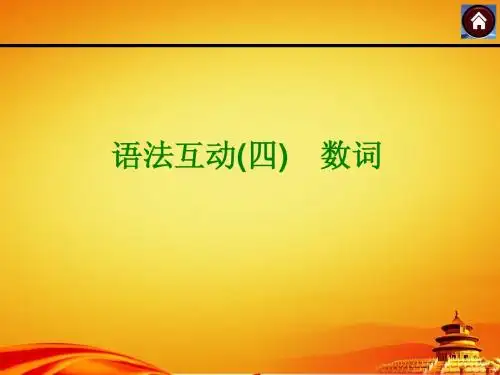
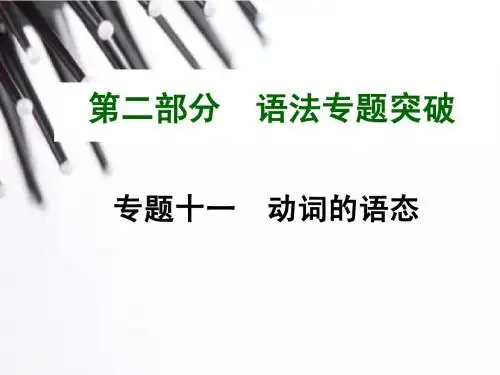
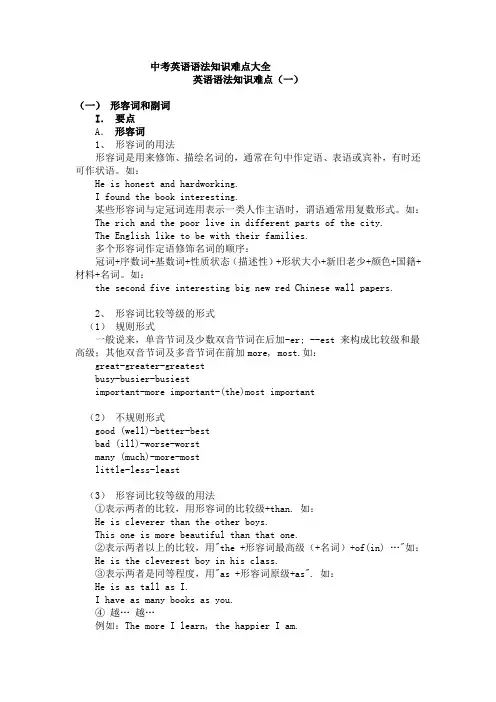
中考英语语法知识难点大全英语语法知识难点(一)(一)形容词和副词I.要点A.形容词1、形容词的用法形容词是用来修饰、描绘名词的,通常在句中作定语、表语或宾补,有时还可作状语。
如:He is honest and hardworking.I found the book interesting.某些形容词与定冠词连用表示一类人作主语时,谓语通常用复数形式。
如:The rich and the poor live in different parts of the city.The English like to be with their families.多个形容词作定语修饰名词的顺序:冠词+序数词+基数词+性质状态(描述性)+形状大小+新旧老少+颜色+国籍+材料+名词。
如:the second five interesting big new red Chinese wall papers.2、形容词比较等级的形式(1)规则形式一般说来,单音节词及少数双音节词在后加-er; --est 来构成比较级和最高级;其他双音节词及多音节词在前加more, most.如:great-greater-greatestbusy-busier-busiestimportant-more important-(the)most important(2)不规则形式good (well)-better-bestbad (ill)-worse-worstmany (much)-more-mostlittle-less-least(3)形容词比较等级的用法①表示两者的比较,用形容词的比较级+than. 如:He is cleverer than the other boys.This one is more beautiful than that one.②表示两者以上的比较,用"the +形容词最高级(+名词)+of(in) …"如:He is the cleverest boy in his class.③表示两者是同等程度,用"as +形容词原级+as". 如:He is as tall as I.I have as many books as you.④越… 越…例如:The more I learn, the happier I am.⑤ You can never be too careful. 越小心越好又如:You can never praise the teacher too highly.你怎么赞扬这个老师也不过分。
中考英语语法复习核心讲义专题一名词及名词所有格一.名词.㈠名词概说1.名词是表示人、事物、现象和其他抽象概念的名称的词,可分为专有名词和普通名词。
2.专有名词是具体的人和事物等特有名称。
专有名词的第一个字母要大写,人名、地名、公共节日及月份、周日的名称等等都是属于专有名词。
如:Yao Ming 姚明;China 中国;Christmas 圣诞节等。
3.普通名词分为可数名词和不可数名词。
㈡可数名词1.可数名词有单数和复数两种形式。
如:an apple; two apples 。
★注意:a 用于以辅音音素(音标) 开头的单数名词前,a useful bookan 用于以元音音素(音标) 开头的单数名词前,an hour3. 可数名词复数形式的的不规则变化(1)变元音字母如:man→men,woman→women,Frenchman→Frenchmen,tooth→teeth,foot→feet;(2)单复数同形如:sheep ,fish,Chinese,Japanese,deer(3)其他如:child – children , mouse - mice4.形式为复数意思为单数如:news, maths, physics, the United States等。
5.只用复数形式如:pants, shorts, clothes,glasses(眼镜)等。
6.复合名词的复数⑴变中心词如:a banana tree – two banana trees ,girl student – girl students⑵man、woman作定语表示性别时,中心词和man、woman都变为复数。
one man teacher - two men teachers , woman doctor – women doctors㈢不可数名词:1.不可数名词的量的表示:(不能直接用数字;不能直接加a。
an;无复数形式)⑴数词/冠词+量词+of+不可数名词如:a piece of paper, two glasses of milk, a glass of water⑵不可数名词被量化后的数应与量词保持一致,如:There are three pieces of paper on the table .2.常考的不可数名词:advice(建议) , information(信息) , news (新闻) , bread(面包) , water(水)等。
最新2015中考英语语法总复习讲义金社中学内部资料专题一名词名词是中考考查的重点。
考查内容主要为:1. 名词单、复数的变化规律及其用法;2. 不可数名词量的表达法;3. 名词所有格的变化及其用法;4. 名词作主语的一致问题;5. 常用专有名词的表示法;6. 具体语境中名词的词义和一些常用易混淆名词的区别。
Ⅰ.名词的定义名词是表示人、事物、现象和其他抽象概念的名称的词。
名词可分为专有名词和普通名词。
专有名词是具体的人和事物等特有名称。
专有名词的第一个字母要大写,人名、地名、公共节日及月份、周日的名称等等都是属于专有名词。
(见资料)如:Yao Ming 姚明;China 中国;Christmas 圣诞节等。
Ⅱ. 可数名词和不可数名词普通名词按照其所表示的事物的性质分为可数名词和不可数名词。
1.可数名词可数名词有单数和复数两种形式。
如:an apple; two apples 。
★注意:a 用于以辅音音素( 指音标) 开头的单数名词前;an 用于以元音音素( 指音标) 开头的单数名词前。
如:a book/b uk/, a useful/ju:sful/ book ,an apple/’aepl/ ,a red apple , an hour/’aua/2.不可数名词: 不可数名词包括物质名词和抽象名词,没有复数形式。
(1)物质名词。
如:water; rice; tea; milk; food; fruit; meat; fish(鱼肉); chicken(鸡肉); beef; mutton; orange(橙汁);sugar; salt; paper(纸); porridge; bread; sand; juice等。
这类不可数名词需要计量时要在名词前加表示量的词。
如:a cup of tea; two bags of rice; three bottles of water等。
(2)抽象名词。
如:news; music; time(时间); information等。
(3)不可数名词不能与数词或不定冠词连用。
(4)注意有些名词既可做可数名词也可做不可数名词。
如:fish; time; glass; orange; room; noise; chicken等。
但使用时一定要区分它们表达的不同意义。
Ⅲ. 名词的数(1)元音或词尾发生变化如:man→men; woman→women; Frenchman→Frenchmen; tooth→teeth; foot→feet; child→children(2)单复数形式相同如:sheep→sheep; fish→fish; Chinese→Chinese; Japanese→Japanese; yuan→yuan(3)形式为单数意思为复数如:people,police(集合名词)(4)形式为复数意思为单数如:news, maths, physics, the United States等。
(5)只用复数形式如:pants, shorts, clothes,glasses(眼镜)等。
3. 不可数名词的量的表示:(不能直接用数字;不能直接加a。
an;无复数形式)(1)表不定数量时,一般用much,(a)little, a lot of/lots of, some, any等词修饰。
(2)表确定数量时,一般用―数词+量词+of+不可数名词。
如:a piece of paper, a piece of news, a bag of rice, two glasses of milk, four bottles of waterⅣ.名词的所有格:1. 有生命的名词所有格(1) 单数名词后加’s 。
如:my brother’s book(2) 不以s 结尾的复数名词后加’s 。
如:the children’s football(3) 以s 结尾的复数名词后加’ 。
如:the boys’ game(4) 以s 结尾的专有名词后直接加’ 。
如:Dickens’ no vels(5)某物为两个名词共有时,在第二个名词后加’s : 如:Tom and David’s room.(6) 表示两个名词各自拥有的东西,在两个名词后都加’s: 如:Tom’s and David’s rooms.2. 无生命的事物的名词所有格(of所有格)(1)of+名词。
如:a photo of my family, the door of the classroom注意:“of+名词’s/名词性物主代词” 构成双重所有格如:a friend of mine, a friend of Jim’s。
(2) 表示时间或距离,国家,城市的方法。
也可用’s来构成所有格▲如:ten minutes’ drive十分钟车程;a month’s holiday一个月的假期。
China’s capital(3)表称呼、职业等名词的所有格可以表示人的住所或工作场所。
所有格后面的名词一般被省去。
如:at his brother’s; at the doctor’s; at the barker’s;at Mr Read’s(4)用所有格表示节日的方法:如:Teachers’ Day; Children’s Day.(除了父亲节和母亲节其他节日我们都用名词复数的所有格表示。
)如:Mother’s Day; Father’s Day.▲(5).由some、any、no、every与one、body 结合的复合不定代词something 、anything 等和else 连用时,所有格应加在else的后面。
This is _________________(somebody else ) pencil .四、名词作句子成分:★1.名词作主语1).表示时间、金钱、距离作主语时,谓语动词用单数。
Two hours _______(be) enough for us to get there .2).量词短语“数字+量词+ of +…”作主语时,谓语动词应与量词保持一致。
A pair of shoes _______(be) under the bed . Two pieces of paper _______(be) on the desk .3).名词+介词(with、except 、along with ….)+名词作主语时,谓语动词应与前面的名词保持一致。
The teacher with the students _________(be) planting trees on the hill .4).短语“neither…nor…、either…or…、not only…but also …‖连接主语时,谓语动词实行就近原则。
Neither he nor I ______ (be) a Frenchman .★2.名词作定语1).名词作定语时,一般用单数形式。
变复数时,名词中的中心词变为复数形式。
如:a banana tree→banana trees; a shoe factory→shoe factories There is a shoe factory near the school .2).名词作定语时,个别情况用复数形式。
(sport )The sports meeting will be held next week .3).man、woman 作定语表示性别时,man、woman随后面的名词单复数而变。
QQ378459309制作one man teacher two women teachers专题二冠词中考对冠词的考查主要为:不定冠词a和an的用法,定冠词the的用法,零冠词的用法,习惯用语中冠词的位置及使用。
Ⅰ.冠词的定义冠词是虚词。
通常放在名词之前,用来说明名词所表示的人或事物。
冠词分为不定冠词(a和an)和定冠词(the)两类。
Ⅱ.冠词的用法1.不定冠词a, an的用法(1)泛指某人或某物,但不具体说明何人或何物。
A girl is waiting for you.(2)不定冠词a 用在以辅音音素开头的单数可数名词前;a useful book; a desk;不定冠词an 用在以元音音素开头的单数可数名词前。
如:an old man; an actor; an “m”。
(3)第一次提到某人或某物而非特指时。
如:There is a book on the desk, but the book isn’t mine.(4)表示人或事物的某一类。
如:An elephant is bigger than a tiger.(5)用于表时间、速度、价格等意义的名词之前,有“每一”的意思,相当every 如:three times a week.(6) 表示数量,有“一”的意思,但数的概念没有one强烈。
I have a computer.(7)用在序数词前,表示“又一,再一”I have three books. I want to buy a fourth one.(8)可视为一个整体的两个名词前eg: a knife and fork 一副刀叉(9)用在某些固定词组中:如:have a good time; have a swim ,have a cold , half an hour ,a lot(of), after a while , in a hurry , fora long time, a few ,a little ,at a time ,2.定冠词the的用法(1)用来特指某人或某物,双方都知道的人或物的名词前如:Open the door, please.(2)用于上文提到的某人或某物。
There is a kite on the wall. The kite is new.(3)表示世界上独一无二的事物的名词前如:the sun; the moon; the earth; the sky(4)用在序数词或形容词最高级前,如:March is the third month of a year. He is the cleverest boy in his class.(5)用在某些形容词前,表示一类人。
如:the rich; the poor; the young; the old等。
(6)用在西洋乐器名词前。
如:play the violin(7)用在表示方位的名词前。
如:in the east/north/west/south(8)用在表示山脉、海洋、江河、湖泊、群岛、建筑物、名胜古迹等专有名词前或用在由普通名词构成的专有名词前。